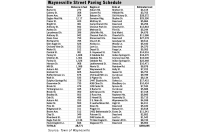Pegging property values in Haywood gets down to brass tacks
With a clipboard under one arm and a giant measuring spool under the other, Greg West climbed into a county-marked truck last Wednesday, cranked the engine and consulted a large Waynesville map on the seat beside him.
“Today we’re hitting Blink Bonny,” he said, planting an index finger on street in a traditional middle class suburb.
West would spend the next eight hours slowly cruising Blink Bonny’s neighborhood streets, eyeing each house from the curb or even loitering in the driveway for telltale signs of its worth.
If anyone’s home, they might mistake him for a stalker. But in fact West is part of a team of Haywood County property appraisers tasked with assigning a new dollar value to each home, lot and tract of land — a dollar value which in turn will determine how much you pay in property taxes.
It’s been five years since the last countywide property assessment. In the past, you could count on values to go up with each reval, but it’s a different ballgame this time. The volatile real estate market has made it tougher for West and his compatriots to pin down accurate values.
With fewer homes selling, there’s less of a baseline to go by. And just because a home sold for one price six months ago doesn’t mean that’s still what it is worth today.
Related Items
The county essentially wrote its own computer program to calculate property values, taking dozens of variables into account before spitting out a number. The finely-customized formula carves the county up into 700 neighborhoods of like homes. It was lot of work on the front end — entering not just the number of bedrooms, square footage and whether a home has a garage — but also the school district, proximity to town parks or mountain views.
West’s property drive-by is now a time of reckoning as the three-year process concludes. West and the rest of his team are laying a pair of human eyes on each house to make sure their computer-generated values are right.
The property appraisers are in the home stretch of that task, having visited nearly all the county’s 50,000 parcels from Crabtree to Cruso, from Balsam to Beaverdam, from Max Patch to Maggie.
The verdict so far?
“It’s been fairly accurate. We put quite a bit of work into it with neighborhood delineation. It gave us a pretty good start,” West said.
Testing the formula is not hard. They visit homes in the neighborhood that have actually sold and compare the actual selling price to the computer-generated value.
In Blink Bonny, West’s first test of their formula was a 3.5-acre tract. The computer pegged its market value at $77,800. It recently sold for $77,500, a mere $300 difference.
“Our formula fell right on the money,” said Ron McCarthy, a property appraisal consultant with RSN Appraisal assisting the county with the revaluation.
McCarthy downplayed any role luck played. They are just that good, he said.
“Luck is the residue of design,” McCarthy quoted.
But to make sure, West pointed his car a couple of streets over where a home had recently sold. The computer formula put the home at $315,000 but it sold in real life for $365,000. Suddenly things weren’t looking so rosy. West set out to uncover the discrepancy.
He pored over the county’s data sheets for the home and found the culprit. It had been given a quality grade of average — a “C” on a scale from F to A+.
But this three-story house sported stacked stone, beadboard ceilings in a wrap-around porch, octagon attic windows and other classy features. Compared to the brick ranch homes on the rest of the street, a “C” rating was too low.
He changed the quality to a B+. Running the formula again but with the corrected data, it came up within a few thousand dollars of nailing the real selling price.
West was relieved. The formula itself wasn’t wrong — just the data that was plugged into it. With several dozen variables factored into the formula, if any of them are wrong, the value it spits out will likewise be wrong.
And that’s precisely West’s job during the drive-bys: to ensure the underlying data for each house is right.
Does the home have a new garage or deck? Has it fallen into disrepair? Is it junked up with a sofa on the front porch? Has the gravel driveway now been paved?
At one home, West did a double-take after spying a second-story over the garage with curtains and blinds visible inside the window.
“Looks like they added a bonus room,” West said, something his sketch of the home in the county’s records didn’t show.
West recalibrate the home’s square feet, triggering a higher value.
Three doors up, West’s keen eye struck again. A brick patio near the front door seemed in mint condition — no moss stains on the pavers, which you’d expect with a ‘70s era house. Either they had recently invested in a pressure washer or the patio was new.
West lifted his tape measure from the back seat and climbed out of the truck. He rung the bell and met a particularly helpful homeowner who not only confirmed that the front patio was new but volunteered that there was another new patio out back. Both would boost the home’s value.
“He had a keen eye to notice that,” McCarthy said of West’s detective work. “That’s why we do the drive-by.”
McCarthy put his own skills to work at the next house in a just-for-fun blind match-up against the computer formula. He sized up the house from the car window, glanced at the sketch of its footprint and threw out his best guess. He was just a few thousand dollars off from the computer-generated value of $300,000.
That likewise bodes well for the county’s modeling — the computer formula came up with the same value as a seasoned appraiser on the ground.
Yet there’s all sorts of factors that might lead appraisers to tweak your home value during the drive-bys. If the neighborhood is uniform — homes of same quality and condition — it’s an easy day.
“If it’s in-town homes on quarter-acre lots, you can just go bam, bam, bam, bam,” West said.
But there’s usually more variation than that.
New windows and a freshly shingled roof? This could earn you brownie points for your home’s condition, and a slight bump in value. Sagging gutters and mildewed sills could bring you down a notch.
“This is like the quality control,” McCarthy said of their work.
The labor intensive process can seem never ending, and indeed as soon as this reval is finished they county will soon start ramping up for the next one another four or five years away.
Attention Haywood County property owners
Start watching your mailbox in March for a notice from the county reflecting the new and current market value of your home.
In North Carolina, counties are required to reassess property values every few years. The revaluation — or “reval” — is intended to level the playing field, bringing the county’s assessed value of your property in line with the true market value so everyone is paying their fair share come tax day.
Don’t assume that your property taxes will go up or down just because your property values do, however. Haywood County commissioners won’t set the actual tax rate until June. The tax rate is then applied to your property value to determine your tax bill for 2011.









